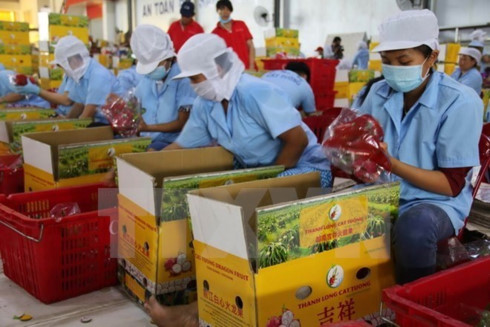Consistent quality a must for RoK exports
Domestic companies have not taken full advantage of the incentives offered by preferential tariff policies for Vietnamese firms to sell products to the Republic of Korea, according to the deputy director-general of the Asia-Pacific Market Department under the Ministry of Industry and Trade (MoIT).
- MoIT advises businesses to learn more about UAE export regulations
- Businesses return to HCM City’s pavements
- 91 of Vietnam's leading tourist businesses in 2017 honored
Le An Hai said that the RoK could be a great market for Vietnam’s agriculture, forest and fishery exports, but Vietnamese agricultural exports accounted for only a small amount of Korea’s total agricultural import value, which was around US$100 billion last year.
Hai spoke at a seminar on promotion of processed Vietnamese food, seafood and agricultural product exports to the RoK held in Ho Chi Minh City on July 28.
Reduced tariffs are available under the Vietnam-RoK Free Trade Agreement, which came into effect in December 2015, and the ASEAN-RoK Free Trade Agreement, offering opportunities for Vietnamese exports.
 |
“Though China is still the most important market for Vietnam’s agricultural products [it imported US$16 billion worth of Vietnamese agro-forest-fishery products last year], the RoK is one of our top priority markets,” he said.
“Like Japan, Australia and New Zealand, the RoK is a very strict market in terms of required quality for imported products. If we can win over these markets, we can access many other markets more easily,” he added.
According to the General Department of Customs, last year Vietnam imported 32 billion USD of the RoK’s products, up 15.9 percent year-on-year, while exports were worth 11.4 billion USD, up 28 percent year-on-year.
In the first six months of the year, bilateral trade between Vietnam and the RoK reached 29.1 billion USD, up 45.5 percent compared to the same period last year.
The MoIT is launching many efforts to help local firms enhance exports of Vietnamese agro-forest-fishery products to the RoK to achieve bilateral trade value of 70 billion USD by 2020.
Products with potential
Yoon Byung Soo, product strategy director of Korean conglomerate Lotte Mart Vietnam, said that Vietnamese dried mango, dragon fruit, coconut-related products and coffee were favoured by many Korean consumers.
“Since Vietnam has many fruits that the RoK cannot produce, our supermarket chains are very interested in these products,” he said.
Yoon said that bananas were a potential product for the RoK because Vietnamese bananas have good quality and a competitive price similar to the Philippines’, which is a main source of imports for Korea.
“Recently, our team from Korea visited Vietnam and signed a contract to import 100 tonnes of bananas,” he said.
However, he said that Vietnamese banana growers should pay more attention to ensuring consistency in the quality of bananas year-round as well as the hygiene of farms.
Another issue is the hiring of under-aged workers by farmers during harvest season, he said, adding that the owners of the farms could be fined for doing so and the reputation of the buyers could be damaged.
He said that Vietnamese firms should also improve product labels and packaging.
Yoon said that he noticed that some Vietnamese product packaging had colourful labels, but foreign consumers preferred labels with basic colours.
Changing designs of packages could increase sales of products significantly. One example was the new label for Cuc Da tissue, which increased sales by 80 percent in only three months.
Yoon said one of the good points of Vietnamese products was the competitive price. However, to enter a market and win it over, especially through a supermarket chain, the products should be unique.
"If the firms sell the type of products that are very common on the market, they will find it more difficult to compete with others that entered the market before them," he added.

